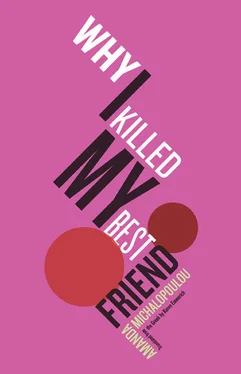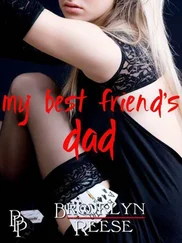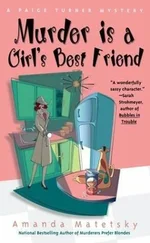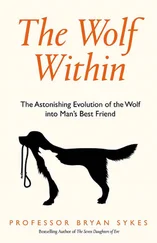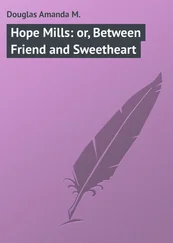We go into my room and play doctor. Anna is the doctor. She examines our behinds and pinches us with her nails when she has to give an injection. She writes us prescriptions for eye drops. Suddenly, as if she’s just remembered something very important, she jumps to her feet and shouts, “Enough of this silly stuff! Let’s go to the demonstration! We’re the League of Democratic Women!”
“I’m not coming to the demonstration,” says Fotini. “I don’t like that game.”
Anna’s face clouds over. “It’s not a game, merde. It’s the struggle for a better life!”
“ No way am I playing,” Fotini says.
Anna goes over and pinches her. “I said, it’s not a game .”
Fotini doesn’t cry, just opens her mouth wide.
“Close your mouth, Daphne. A fly might get in.”
I don’t have to say it twice.
“Where do witches live?” she asks.
She’s frozen in place, twirling a lock of her hair. That particular vanity seems to run in the family: Antigone’s braid, Anna’s barrettes.
“In caves.”
“What do they eat?”
“Grasshoppers!”
She gasps in wonder. That must run in the family, too — Anna was always drawn to strange people, bizarre stories. The little girl scratches at her knee, takes a step backward, and stumbles.
“Watch where you’re going! Why don’t you walk normally, silly?”
“I’m scared you might turn me into a tiger, miss.”
“As long as you behave, there’s no reason to be afraid.”
Daphne nods her head frantically, then runs out of the classroom, pulling the door shut behind her. I listen as her footsteps clatter down the stairs.
The room looks as if a bomb went off. Surprised by Daphne’s sudden attack, the children left colored pencils, papers, markers, erasers lying everywhere. I pick it all up, leave everything in an ordered pile on the desk and go to find Saroglou.
“Have you ever seen such a child?” she exclaims.
“I know her mother. She used to be a friend of mine.”
“She must be paying for some pretty juicy sins, to have a child like that.”
“Oh, I don’t know. .”
“Why, was she a bookworm or something?”
“Not at all. She was captivating,” I say.
“Well then, it’s nature punishing her.”
That’s it. Daphne torments Anna the way Anna once tormented me. History repeats itself.
“Don’t you dare switch on the light!” Kayo pulls a pillow over his face. Beside him, Anna-Maria does the same: she puts a leg over her eyes and starts to lick herself.
“But it’s almost evening! You’re still in bed?”
Kayo stretches and twists a few times under the sheet. I stroke his hair: thousands of tiny rasta braids, rough to the touch, like everything about Kayo. He’s changed. New York brought him down, made him melancholy. His beauty dried up from within. Only his eyes still spark the way they used to.
“Get up! I’ve got news.”
“Anna?”
“How did you know it’s about Anna?”
“You’ve got this look on your face as if you were nineteen years old again.”
In actuality, I’m almost thirty-five. But if we see life as a cycle, I’m still right where I was. I live in the same apartment in the blue building, not with my parents anymore, but with a depressed homosexual. The gap between the balcony rails has been there for nearly a quarter of a century, mocking my useless attempts at escape. Nothing else from that era remains. The pantry is a darkroom, where we print our posters. The house hasn’t smelled of lavender or steam irons since my parents decided to move to Aegina for good. Kayo brought an air of healthy living when he came: he doesn’t smoke and gets high off scentless little pills. The bathroom smells of aftershave, the kitchen of cat food. I hate cats, but there was nothing I could do: when he showed up with an angora that was just skin and bones, as lost in life as he was, I had to either take both of them in or send them both away. “Her name is Anna-Maria,” he’d said. “Why? She doesn’t look much like a princess.” “Yes, but she’s an odd mix of daring and timid,” he answered slyly. Apparently the cat had Anna’s daring, but my timidity.
Kayo, Anna-Maria, and I have been living together since New Year’s, 1997. That day when he showed up, it had been roughly twenty years since I swallowed my luck in the form of the coin from a New Year’s pie, and ten years since the show for graduates of the School of Fine Arts, when I thought painting was the most important thing in the world. Just five years since Aunt Amalia died, and since we adopted the slogan “I bleed, therefore I am.” The socialists are still in charge of the country, they built a subway and a few highways to placate the populace. But we didn’t give in: we made posters urging an occupation of the Attic Highway. We painted the facades of a few banks with Day-Glo paint. Lots of people still think we’re just pranksters. That a revolution based on colors, music, and demands for a better life is childish. And of course those were difficult years to be launching protests in Greece: all of a sudden the country was flooded with new money, fresh capital that pulled the wool over people’s eyes, tricked them into thinking the prosperity was real. So we started to attend demonstrations in more affluent countries, where people had a better sense of what it meant for that flood of money to drown you, in the end. In 1998, in Geneva, Kayo and some others overturned the Central Bank director’s Mercedes and we spent two nights in jail. In 1999 we sat on a crowded bus for days just to go back and shake the hands of the Zapatistas, members of the Indian KRRS, the landless of Bangladesh, people of all stripes who were protesting third world debt, genetically modified food, and the colonization of the global South. In June of that same year we flew to Nigeria to shout slogans against the oil companies, standing in a crowd of thousands to welcome Owens Wiwa as he returned to his homeland from exile. I was hesitant, but in the end I decided to go to Ikeja, where I located our old house. Kayo and I stood there for a while watching a couple of white kids playing in the yard. But that’s another story.
Five months later was Seattle. Kayo and I vomited side by side at the barricades. It was the most tear gas we’d ever experienced. And yet it was a perfect moment: no central committees, no leaders, no dogma. Look, Anna , I kept thinking, it’s happening, it’s actually happening . It had proven impossible to follow her parting advice, to live like an amoeba.
In the breaks between protests we come home, take hot footbaths, look for work. This year I found the school, Kayo is doing some underwear modeling. At night he prints T-shirts with old situationist slogans: In a society that has abolished any kind of adventure, the only adventure that remains is to abolish the society . In the morning I find him curled up with Anna-Maria in my parents’ old bedroom, a Kodachrome icon of the Virgin Mary that my mother left to protect me hanging on the wall above him. Kayo adores it. It’s a bad habit he picked up in New York: he’s always coming home with the cheapest, kitschiest junk. A mismatched family of characters, childish yet lurid, occupies his bedside table: a pink plastic Hello Kitty, a music box topped by a fake ballerina with gold pointe shoes, a plastic camera that squirts water, one of those flowers that bobs up and down on its stem when there’s music playing, a Statue of Liberty made of hot pink foam.
I sleep in my childhood room. There’s nothing angelic or little-girlish about it. “It’s an absolute mess in here,” Kayo mutters when he’s in a bad mood. But I like it that way. Amid the newspaper clippings, posters, books, packs of anti-capitalist stickers, I’m somehow able to find myself. “ Lose yourself, you mean,” he says. To keep myself from hitting him I psychologize his own mania for cleanliness: he’s biracial, the son of a white woman who washed him incessantly when he was a kid, and ironed a new shirt for him every day so that none of the other kids could say he smelled bad. Kayo smells wonderful, in fact, even when he’s in a funk. I’m the one who always seems to need a shower.
Читать дальше
